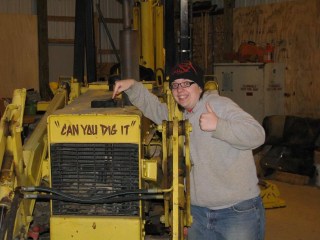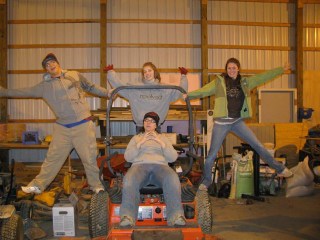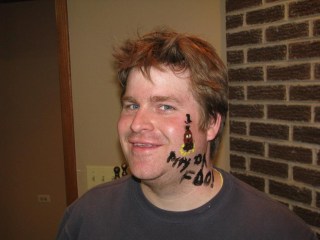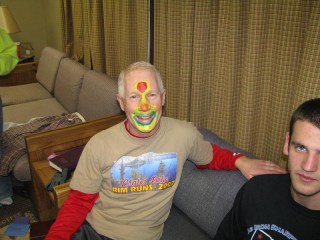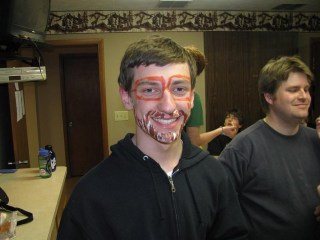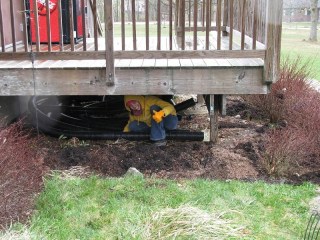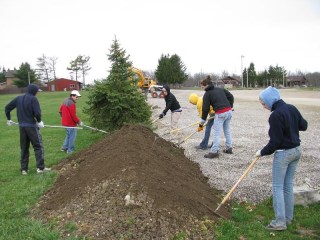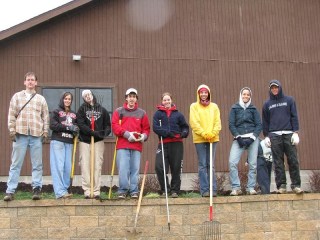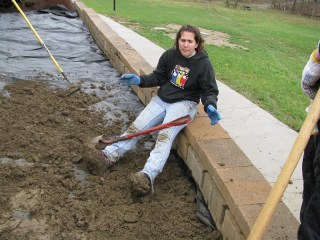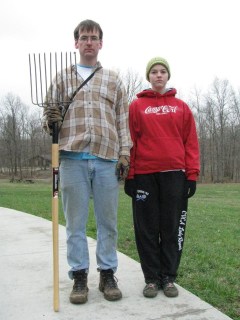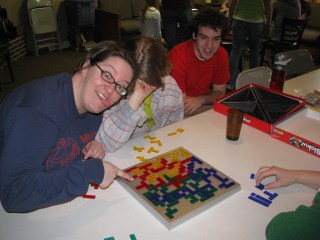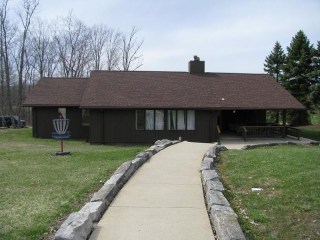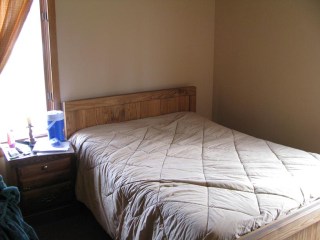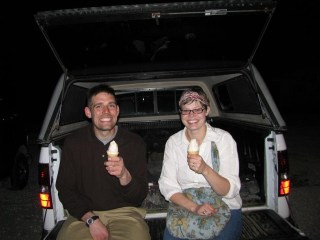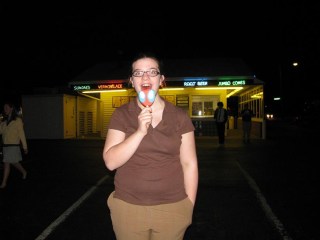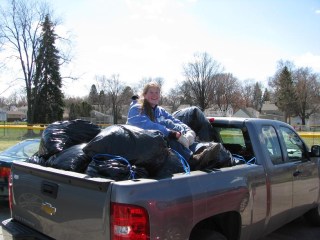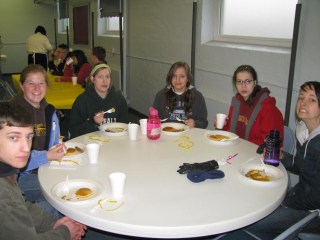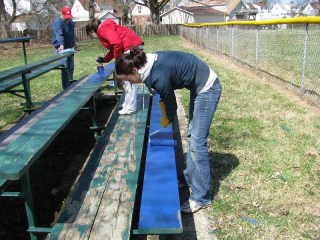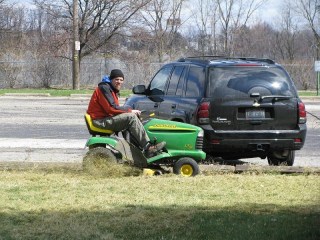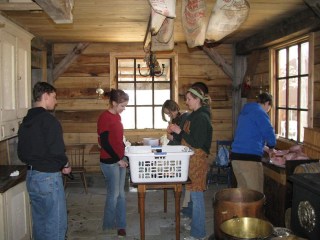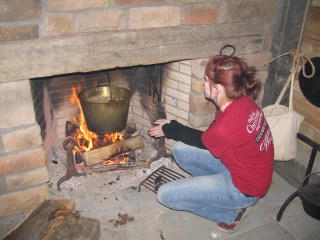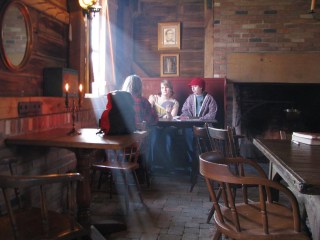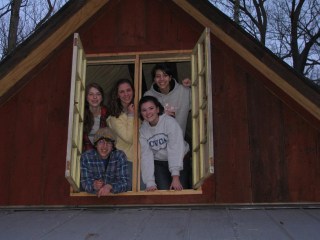Wednesday bloomed with me feeling slightly under the weather (but just slightly). The solution was pretty obvious – I needed to go to Dunkin’ Donuts to get a hot chocolate and a sandwich. Sad to say, but that solution worked.
Once I got back, I waited for things to get rolling, and we were shortly divided up into teams. I was once again staying at Camp Carl, and I was in charge of five students. One of Nate’s friends works at the camp, and he told us to meet him by the trailhead near the cabins where most of the group stayed on Saturday night. We wandered down the hill to the trail, and we waited for a few minutes until Nate’s friend pulled up in a pickup truck full of tools and lawn implements.
 We were asked to clean up the leaves near two of the cabins. Another group had cleaned up most of the leaves, but they had run out of time before doing this fairly small area. Once we had finished that, we were told we could clean up the leaves from off the walking trail, and to clean up any brush that hung over the sides of the trail. We were given three leaf blowers (one of them was a big-time backpack blower), a couple of rock rakes, several pairs of branch cutters, and a can of gas-oil mix for the blowers. Thus equipped, we were left to our own devices.
We were asked to clean up the leaves near two of the cabins. Another group had cleaned up most of the leaves, but they had run out of time before doing this fairly small area. Once we had finished that, we were told we could clean up the leaves from off the walking trail, and to clean up any brush that hung over the sides of the trail. We were given three leaf blowers (one of them was a big-time backpack blower), a couple of rock rakes, several pairs of branch cutters, and a can of gas-oil mix for the blowers. Thus equipped, we were left to our own devices.
I have to admit that I was very skeptical about the blowers. The leaves were wet from the previous two days’ snow and rain, and there was even still a dusting of snow in the shady areas. Also, Nate’s friend had made the assumption that we could start the leaf blowers. Happily, they were similar to my old weed whacker, and after a couple of minutes of priming, choking, and yanking and yanking and yanking, I got the first one started. The other two started more easily. Later, one of the student pointed out that the instructions were printed on the nozzle in both English and Spanish. Hah! Who needs reading?
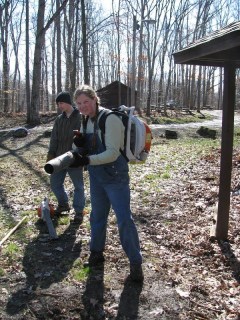 It turns out I was wrong about the blowers. They worked really well. I had three students go at it with the blowers. They blew the leaves toward the woods, and once the piles were too big, I had two students use the rock rakes to rake/shovel the leaves into the woods. Meanwhile, I went around and cleaned up sticks and branches. It was an efficient operation, but it still took us about an hour and a half or even slightly more. Since Nate’s friend had told us to come and find him near the other end of the walking trail when we were done, I think he thought we were going to be done with the whole project by lunch. Needless to say, this did not happen.
It turns out I was wrong about the blowers. They worked really well. I had three students go at it with the blowers. They blew the leaves toward the woods, and once the piles were too big, I had two students use the rock rakes to rake/shovel the leaves into the woods. Meanwhile, I went around and cleaned up sticks and branches. It was an efficient operation, but it still took us about an hour and a half or even slightly more. Since Nate’s friend had told us to come and find him near the other end of the walking trail when we were done, I think he thought we were going to be done with the whole project by lunch. Needless to say, this did not happen.
When we did finally wrap up the area in front of the cabins, I sent three students down the trail blowing leaves (one to the left, one to the right, and the big backpack blower doing the middle of the trail). The remaining three of us followed behind cutting down branches and trimming back brush from the trail. Again, I thought it was pretty efficient. We made our way down a big hill and got to a fun but treacherous-looking bridge. We stopped for a short rest, we moved a downed tree, and we took advantage of the photo op. We then pressed on up the other side of the hill. The blowers moved on out ahead, which was not too surprising, since they were mechanized. We followed along as best we could. 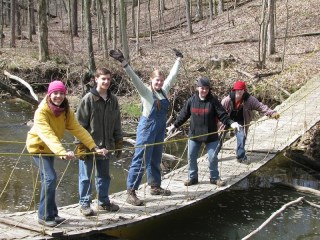
We got to the camp’s archery area and cleaned that up – it was pretty thick in leaves and sticks. Once we cleaned that up, we decided to call it lunch, so we hoofed it the mile or so back to the camp. As far as I could tell from having run the trail on Sunday, we were about halfway when we broke for lunch.
We had a mellow – and shortish (about 30-minute) – lunch, and hoofed it back down the trail again. In the meantime, we had picked up a couple of pairs of hedge trimmers, which were more effective against the bramble bushes we were starting to come across. We picked up where we’d left off near the archery area, and the leaf-blower folks took off. This turned out to be okay, since they were able to do a side trail that we had been asked to do. The brush trimming team never did make it down the side trail, but at least it was blown clear.
As we got to the home stretch, we hit more and more bramble patches. We tried cutting them back or even cutting them off at the ground. I also had a hand at trying to use a spade to remove rocks from the trail, and I got out several before turning a corner and seeing the whole trail full of buried rocks. I gave up at that point. As we got close to finishing up, some of the leaf blowers came back to help with brush control. I have to admit that I was happy to let them help. I have back issues, and I had spent the entire day bent over picking up sticks or cutting brush. My back was having great difficulty changing positions (to bend over or to straighten up). I let the younger set take care of the last several hundred yards.
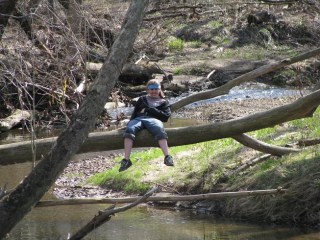 We finished up the trail at a small outdoors chapel area, and we gathered up the tools and wandered down the dirt road that the trail came out onto. We were over a mile from the camp, but it was a nice day, so we took our time. We stopped at the stream near the cabins, and sat there for awhile (I stood since I was not sure I could get back up if I sat down). After puttering there for a few minutes, we headed back to our quarters.
We finished up the trail at a small outdoors chapel area, and we gathered up the tools and wandered down the dirt road that the trail came out onto. We were over a mile from the camp, but it was a nice day, so we took our time. We stopped at the stream near the cabins, and sat there for awhile (I stood since I was not sure I could get back up if I sat down). After puttering there for a few minutes, we headed back to our quarters.
Once there, I found out that four others wanted to go running – Nate, Jim, and two students. They had a “cool run” near the large reservoir nearby. So, I threw on my shoes and we all piled in my car. Now, I know it seems stupid to run after complaining about my back, but it does seem to help. It loosens the muscles, and it involves almost no bending.
We went a short distance (three miles) down a tar road that was more potholes than tar, and we came to a bike trail with a big “no parking” sign. We went 10 feet past the sign and parked. One of the students (Matt) took the lead and led us on a wild trail run that was windy, muddy, and hilly, and in one area the trail had fallen in the lake. It was a slow run, but we had a good time giving Matt grief about his choice of trail. By the end, we had only run about 20-25 minutes, but it was enough to loosen up.
I let everyone else shower when we got back, so I was able to let the hot water do its magic on my back. I had even checked online to see if my chiropractor was open, but he was closed on Wednesday afternoons, so I had to let hot water do the best it could, and I headed to supper, which was in a big multipurpose room in the next building. We were able to eat with plenty of space. We had an excellent Cincinnati-style chili (chili on top of spaghetti), and then we set up for the evening’s entertainment – the annual Diakonos talent show.
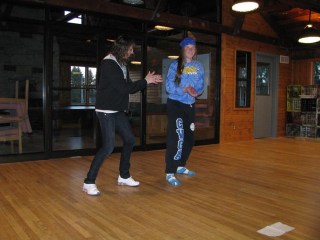 Every year, students (and chaperons) sign up to do things of varying degrees of talent, and they are a good time. This year, I think we had about ten acts, two of which were mine. I had four Ceili Club dancers on the trip who wanted to dance a reel for everyone (and I had access to iTunes so I could get a reel for 99 cents). I also had four members of my Royal Fools improv group along, so I signed them up to do a short skit (game) as well. I was very proud.
Every year, students (and chaperons) sign up to do things of varying degrees of talent, and they are a good time. This year, I think we had about ten acts, two of which were mine. I had four Ceili Club dancers on the trip who wanted to dance a reel for everyone (and I had access to iTunes so I could get a reel for 99 cents). I also had four members of my Royal Fools improv group along, so I signed them up to do a short skit (game) as well. I was very proud.
Some of the other acts included a thrown-together joke-telling group that told lame jokes that were funny because they were lame, and a group where Craig used word art to change a student’s name into a picture of a pig, a girl who showed off her solo skit that she used in speech competitions, a different dancing group, and a couple of guys rapping (which was the second year in a row – they are a big hit). Everyone seemed to have a fun time, and we got things cleaned up a little over an hour after the show started.
Back in the main living quarters, we putzed around until Craig was ready to lead devotions. We sang three or four songs, and then Craig walked us through a PowerPoint review of the Romans passages we had looked at, and he looked at what it means to live “in community.” Again, I wish I’d written these things down, but as best as I can remember, Craig talked about putting the needs of others above your own, willingness to build each other up, willingness not to judge on appearances (and how Americans don’t have people over because the house is too messy or the like), and he stressed a proximity that would be needed to maintain a community – it is hard to have community when you are an hour apart. He had some good points, and I hope the kids (and I!) remember at least some of them.
